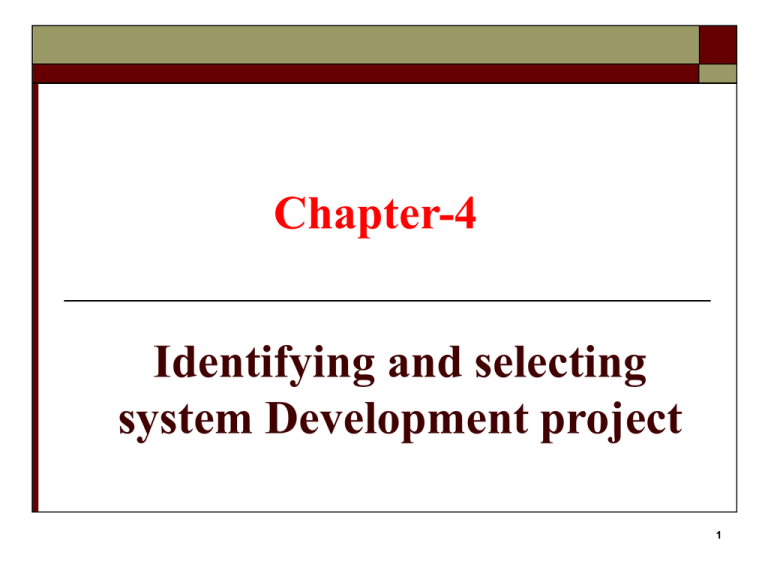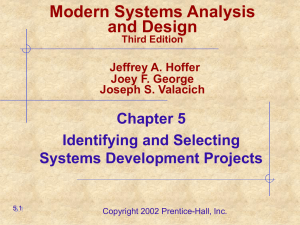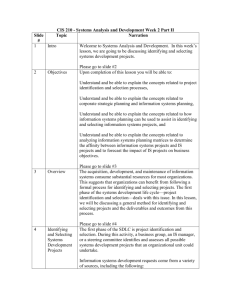Document
advertisement

Chapter-4 Identifying and selecting system Development project 1 Identifying and selecting system Development project The first phase of the SDLC is Identifying and selecting system Development project. During this activity, a senior manger, a business group, an IS manager, or a steering committee identify and assess all possible system development projects that an organization unit could undertake. 2 The Process of Identifying and Selecting IS Development Projects 1. 2. 3. Identifying potential development projects Classifying and ranking projects Selecting projects for development 3 Identifying and selecting system Development project Potential development projects are identified by: A key member of top management. A steering Committee: composed of a cross section of manager with an interest in systems User department CEO of small sized organization Senior executive in a large organization Head of the requesting unit Committee of from the requesting department The development group or a senor IS manger 4 Identifying and selecting system Development project Top-management Steering Committee Cross-functional focus Greater organizational change Larger and riskier project User development Greater strategic focus Largest project size/duration Faster development Fewer user Development group Fewer development delays 5 Top-down and bottom-up identification Top-Down Identification Senior management or steering committee Focus is on global needs of organization Bottom-up Identification Business unit or IS group Don’t reflect overall goals of the organization 6 Identifying and selecting system Development project Classifying and Ranking IS development Projects : 2nd major activity in the project identification and selection process focuses on assessing the relative merit of potential project. Performed by top management, steering committee, business units of IS development group Value chain analysis is often used Method to analyze an organization’s activities to determine where value is added and costs are incurred 7 Evaluation criteria when classifying and ranking projects 1. 2. 3. 4. 5. 6. Resources availability: amount and type of resources the project requires and their availability Project size & duration: number of individuals and the length of time needed to complete the project Value chain analysis: Extend to which activities add value and costs when developing product/services Strategic Alignment: Extent to which the project is viewed as helping the organization achieve its strategic objectives and long-term goals. Technical difficulty/risks: Level of technical difficulty to successfully complete the project which give time and resource constraint Potential benefits: Extent to which the project is viewed as improving profits, customer service 8 Identifying and Selecting IS Development Projects Selecting IS Development Projects: project selection decision Process of considering short and long-term projects Projects most likely to achieve business objectives are selected Decision requires consideration of: 5.9 Perceived and real needs Potential and ongoing projects Current organizational environment Existing and available resources Evaluation criteria 9 Identifying and Selecting IS Development Projects Selecting IS Development Projects Outcomes Project Acceptance Project Rejection Delay Refocus End-User Development Proof of Concept 5.10 10 Information Systems Planning Traditional Project Identification and Selection Solves isolated problems Focuses on business processes Does not easily allow for organizational change Planning-Based Approach to Project Identification and Selection Focuses on present and future information needs Information needs change slower than business processes 11 Information Systems Planning Need for planning Improperly planned projects result in systems that cannot be shared across an organization As business processes change, lack of integration will hamper strategy and business process changes 12 Information Systems Planning Information Systems Planning (ISP) An orderly means of assessing the information needs of an organization and defining the systems, databases and technologies that will best satisfy those needs Three key activities: 5.13 Describe the Current Situation Describe the Target (or Future) Situation Develop a Transition Plan and Strategy 13 Information Systems Planning Information Systems Planning 1. Describing the Current Situation Top-down Planning Bottom-up Planning 5.14 Generic methodology that attempts to gain a broad understanding of the information system needs of the entire organization Generic methodology that identifies and defines IS development projects based upon solving operational business problems or taking advantage of some business opportunities 14 Information Systems Planning Information Systems Planning 1. Describing the Current Situation (Continued) Planning team is chartered to model existing situation Identification of Organizational: Locations Units Functions Processes Data Information Systems 5.15 15 Information Systems Planning Information Systems Planning 1. Describing the Current Situation (Continued) Matrices are developed to cross-reference units 5.16 Location-to-Function Location-to-Unit Unit-to-Function Function-to-Objective Function-to-Process Function-to-Data Entity Process-to-Data Entity Process-to-Information System Data Entity-to-Information System Information System-to-Objective 16 Corporate and Information Systems Planning Information Systems Planning 2. Describing the Target Situation Update list of organizational locations, functions, etc. to reflect desired locations, functions, etc. Matrices are updated to reflect future states Planners focus on differences between current lists and matrices and future lists and matrices 17 Description of three process that play significant role in project selection Value chain analysis Corporate Strategic Planning Information System Planning 18 Value chain analysis Value Chain Analysis consists to analyse an organisation’s activities to determine where value is added to products and or to services and the costs generated for doing so. Purpose It enables to select projects that offer more support to key activities with high costs Criteria can differ from organisation to organisation E.g. criteria used by the EC 19 Corporate Strategy Planning (CSP) Effective deployment of resources require clearly understanding of organisational missions, objectives & strategy Corporate Strategy Planning is a top-down process of three steps CSP is an ongoing process that defines the mission, objectives and strategies of an organisation CSP is a process that is frequently subject to change It requires constant surveillance 20 Process of corporate strategy planning Analysis of strategic position: what is the current position? Desired strategic position: what are the objectives Design of the possible strategies to achieve desired goals 21 Advantages of IS planning 1. 2. 3. 4. Allow to construct ISs that support the whole organisation Allow integration of different tools Avoid data redundancy (process oriented approach vs data oriented approach) Reduce maintenance costs because planned system will require less revision 22 Information system planning (ISP) Information system planning” is different from “project planning” Information System Planning (ISP) is the process by which a company (organisation) analyses its information needs and plan its project carefully ISP is an orderly means of assessing the information needs of an organisation and defining the systems, databases, and technologies that will best satisfy those needs ISP is a top-down process that takes into account the outside forces that drive the business (need vigilance) 23 ISP and Corporate Strategy Planning Current enterprise Current situation for informational needs •Listing of manual & automated processes •Listing of manual & automated data •Technology inventory •Human resources inventory Desired situation for informational needs Future enterprise Strategic plan •Listing of manual & automated processes •Listing of manual & automated data •Technology inventory •Human resources inventory Schedule of projects to transit from current to desired Project 1 Project 2 ---24 Information System Planning ISP requires support of top management and itscommitment to reach desired objectives Description of the current requires a planning team Techniques used to capture information system needs, include Interviewing managers and executives Reviewing corporate documents Analysing competitors, markets and products There are two approaches to describe current situation needs Top down planning Bottom-up planning 25 Step 1: describing the current needs Top down planning is a generic methodology that attempts to gain a broad understanding of the IS needs of the entire organisation Bottom-up planning is a generic IS methodology that identifies and defines IS development project based upon solving operational business problem or taking advantages of some business opportunities 26 Information collected about current situation Locations where the company operates Business unit that operate within a company Functions = cross organisational collection of activities used to perform day-to-day business operation. Processes of a company Data underlying processes Information system represent automated and non automated systems used to support business processes. 27 Outcome = mMatrix of Information systems (IS) * objectives Information systems (IS)/ Objectives Objective 1 IS1 IS2 … X X Objective 2 IS3 ISn X X Objective 3 … Objective j X X 28 Matrix of Information systems (IS) * processes Information systems (IS)/ Processes (P) P1 IS1 IS2 … Pj … ISn X P2 P3 IS3 X X X X X Several techniques of multi-criteria decision could be applied to select IS that satisfies the company’s current needs 29 Step 2 and 3 of ISP Step 2: describing the target situation and constraints Define situation of location, units , functions, processes, data and information system taking into account the trends and constraint of the organisation Target situation could also be described in term of matrix Step 3: developing a transition strategy and plans Plans reflect both short-term and long-term organisational development needs Plans include organisational mission, information inventory, mission and objectives of IS, constraints, long-term plans and short-term plans Selected projects are those derived from ISP and that fulfil the gap between current and desired situation 30



